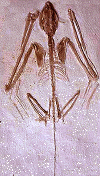
Icaronycteris index. Upper Eocene of Montana (Green R. fm.). The bones that appear to be posterior processes from the elbow area are phalanges. The carpal joint is flexed 180°, and the hand lies under the forearm.
| Chiroptera | ||
| The Vertebrates | Chiroptera |
| Vertebrates Home | Vertebrate | Vertebrate |
|
Abbreviated Dendrogram
|
Contents
|
Chiroptera: bats.
fr upPc.
choice of three (or add your own)
traditional morphology: Archonta :: Dermoptera + *. ;
molecular phylogeny: Laurasiatheria : Eulipotyphla + (Ferungulata + *)
an idiosyncratic attempt at synthesis inspired by Wible et al 2009: Eutheria ::: Laurasiatheria + (Euarchontaglires : Archonta + (Insectivora + Afrotheria) + *) MAK120319
First set of teeth with long, sharp, recurved cusps; jugal reduced, & does not contact lacrimal; two entotympanic elements; posterior laminae present on ribs; extensive use of echolocation with complex adaptations of brain; clavicle large element & articulates with sternal manubrium and with acromion & coracoid processes of scapula; clavicle primary brace for pectoral girdle; scapula relatively unconstrained & can rotate around longitudinal axis; forelimbs & digits (except digit 1) elongated; specialized carpal & elbow joints limited to movement in anteroposterior plane (to control wing membranes in flight and reduce weight of joint?); presence of ulnar patella ("elbow cap"?); distal ulna reduced; flight membranes (patagia) between arm and 5th digit, between digits, hind limbs and tail, and "arm" and neck region; wings have high and variable camber, low wing loading, & low aspect ratio for controlled, high-lift, low-speed flight; chiropatagium between III & IV most important; muscles and elastic fibers in patagia; flight & recovery strokes involve several muscle groups and are less stereotyped than in birds; hind limb usually rotated 90 or 180 degrees from usual mammalian orientation, thin but not reduced in length; fibula usually reduced; complex social behavior and communication; heterothermy reduced metabolism during daily torpor cycle) in some forms as well as hibernation; relatively slow, highly maneuverable flight; many have secondary flight style for very slow or hovering flight (involves wings well anterior to usual level flight position); no cecum; nocturnal or crepescular; numerous ecological guilds.
Links: Willie's Chiroptera Page; Chiroptera; Chiroptera Italica; Comparative Mammalian Brain Collections; Canadian Bat Resources; World bibliography on subterranean Mammalia, Chiroptera; A Checklist of the Mammals of the World: Chiroptera (Bats); Kentucky Bat Working Group (there are many good bat sites, but this may be Best on the Web). ATW
checked ATW050727, revised MAK120316